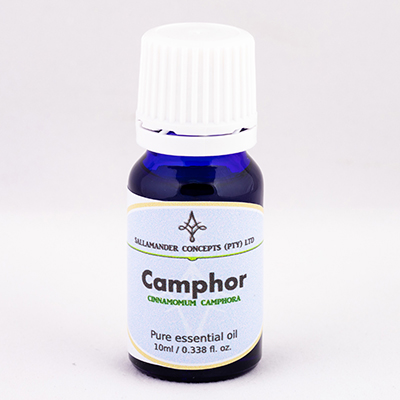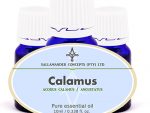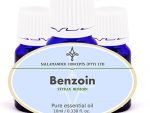Camphor essential oil information (Fractionated : White, Yellow, Brown and Blue)
The Camphor essential oil most commonly used in Aromatherapy is extracted from the Cinnamomum Camphora (also known as Laurus camphora) of the Lauraceae family, and is actually a fraction of the extraction obtained by rectification. It is not a true essential oil as it has been subjected to a process of rectification. It is known as true camphor, white camphor, hon-sho, gum camphor, as well as Japanese and Formosa camphor.
White camphor essential oil contains trace amounts of safrole (a carcinogenic agent). This is generally regarded as to be of no great concern (the amount present is negligible).
It can be used with great effect in vapor therapy to clear the lungs, dispel apathy and calm nervous depression. It has a beneficial effect on psychosomatic ailments, while having some distinct benefits for the skin.
Properties of Camphor essential oil
After steam distillation and rectification under vacuum, it is filter pressed and 4 fractions of oil are produced; known as white, yellow, brown and blue camphor.
The white camphor oil is commonly used in Aromatherapy, as it is considered to be the safest and it has a clear and fresh smell. The brown, yellow and blue camphor is potentially toxic and is considered potentially carcinogenic (since they contain a high percentage of safrole) and are rarely used in Aromatherapy – the yellow camphor fraction is rarely used at a much reduced dilution rate.
‘Green’ Camphor is used in Ayurvedic medicine. We find reports that it originates from the resin of the tree. Reports are found that suggest that remedies available on the market claiming to contain ‘Green Camphor’ actually contain turpentine or derivatives of Turpentine.
Origin of Camphor essential oil
The camphor tree can grow up to 35 meters (100 feet) and the active component is found in every part of the tree. The tree is native to Formosa (Taiwan), China and Japan and can often grow very old. It must be at least 50 years old to produce the oil.
It was a well known remedy against the plague in Persia, now Iran, and was also used in embalming, while the Chinese used it to build ships and temples, because of the durable and aromatic properties of the wood.
Extraction of Camphor essential oil
Camphor oil is extracted by steam from the the chipped wood, root stumps and branches and is then rectified under vacuum and filter pressed. Four fractions of the oil are obtained and the white camphor is widely used. Camphor, a terpene isolated from the oil, is also widely used in medicated preparations.
Therapeutic properties of camphor essential oil
The therapeutic properties of camphor oil are analgesic, antidepressant, anti-inflammatory, antiseptic, cardiac, carminative, diuretic, febrifuge, hypertensive, insecticide, laxative, rubefacient, stimulant, sudorific, vermifuge and vulnerary.
Chemical composition of Camphor essential oil (white)
The main chemical components are:
(+)-Limonene, ρ-Cymene, α-Pinene, 1.8-Cineole, Sabinene, β-Pinene, Camphene, Camphor and traces of Safrole
The brown and blue camphor oil have a very high safrole content, with yellow typically having between 10 – 20 % . These three oil fractions are considered potentially toxic, as well as potentially carcinogenic.
Suggested precautions when using Camphor essential oil (white)
White Camphor essential oil is not particularly sensitizing, although it does oxidize easily. Oxidized oils are far more prone to irritating the skin. We suggest keeping this oil in a dark, cool place (preferably the fridge).
White camphor essential oil contains trace amounts of safrole (a carcinogenic agent). This is generally regarded as to be of no great concern as the amount present is negligible.
The brown and blue camphor oil have a very high safrole content, with yellow having between 10 – 20 %. These three oils are considered potentially toxic, as well as potentially carcinogenic.
Please read our page with heading: Safety with Essential Oils before using this oil.
We recommend the following book as an excellent resource regarding safety:
Essential Oil Safety: A Guide for Health Care Professionals by Robert Tisserand & Rodney Young (#ad)
Therapeutic properties of Camphor essential oil (white)
The therapeutic properties of camphor oil are analgesic, antidepressant, anti-inflammatory, antiseptic, cardiac, carminative, diuretic, febrifuge, hypertensive, insecticide, laxative, rubefacient, stimulant, sudorific, vermifuge and vulnerary.
Uses of Camphor essential oil (White)
Camphor essential oil can be used in the treatment of nervous depression, acne, inflammation, arthritis, muscular aches and pains, sprains, rheumatism, bronchitis, coughs, colds, fever, flu and infectious diseases.
On the skin:
Camphor essential oil is of great benefit when used to massage sore and stiff muscles and works well for this purpose when blended with other essential oils.
A cream or gel containing Camphor essential oil is of great benefit when applied to the skin, treating arthritic pain, rheumatism, sore and aching muscles, or to relieve muscles after exercise.
When applied to the upper chest and neck it can help treat bronchitis and coughs, ‘flu and colds or infections of the respiratory tract.
A compress can be made of camphor and applied to aching joints and sore muscles. For bruises and sprains, cold compresses are effective.
White Camphor essential oil has great value in fighting inflammatory conditions and reducing redness, making it useful when treating acne, burns and sore chapped hands.
Burners and vaporizers
In vapor therapy, camphor oil can be used with great effect for the heart, clearing the lungs and boosting circulation, as well as calming nervous diseases and for convalescence.
Suggested dilution rates for Camphor essential oil (white)
On unbroken skin
Adult skin:
Face: 0.2% to 1.5%
Body: 0.2% to 3%
Bath: 1.5% to 3%
Pain: 1.5% to 5% (on affected area)
3 to 24 months:
Face: avoid
Body: 0.2% to 0.5%
Bath: 0.2% to 0.5%
Pain: 0.2% to 0.5%
2 to 6 years
Face: 0.5% to 1,5%
Body: 0.5% to 2%
Bath: 0.5% to 2%
Pain: 0.5% to 2%
6 to 15 years:
Face: 0.5% to 1,5%
Body: 0.5% to 3%
Bath: 0.5% to 3%
Pain: 0.5% to 4% (on affected area)
Pregnancy:
Face: 0.2% to 1.5%
Body: 0.2% to 2%
Bath: 0.2% to 2%
Pain: 0.2% to 2%
- When in doubt consult your doctor / medical professional before use.
- Most professionals and/or Aromatherapists will always err on the side of safety when giving advice regarding the use of essential oils and oleo resins during pregnancy – This is due to conflicting information available, or the absence of any reliable information.
- Quite a number of Aromatherapists advise that you should avoid essential oils completely while pregnant, specifically during the first trimester. This is a very safe approach but may not be necessary at all.
Breastfeeding: Keep away from the baby while feeding (do not apply to areas that the baby will come in contact with). Rather avoid using on the skin while breastfeeding.
Burners and Vaporizers
2 to 8 drops
General:
- When using for the first time – Always use the lowest dilution rate and build up slowly to the maximum. Stop using all essential oils on the skin if irritation or allergy occurs.
- Any advice or instruction received from a medical professional ALWAYS supersedes recommendations or advice found on this website. When in doubt consult your doctor / medical professional.
Summary
Camphor oil is a balancing oil, it can sedate the nerves and uplift apathy. It can help with feeling cold and reduces inflammation. It is used with great effect to repel insects such as flies and moths. It also has a positive effect in colds and flu, infectious diseases, bronchitis, coughs, and can assist with muscular pains, rheumatism, sprains and arthritis.
Camphor essential oil blends well with
Although essential oils in general blend well together, camphor oil blends particularly well with the Basil, Cajuput, Chamomile, Lavender and Melissa.





